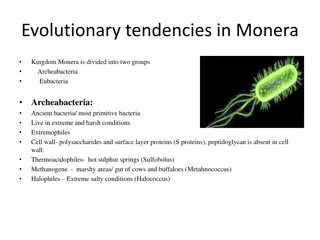Contrasting Kingdoms: Archaebacteria vs Eubacteria
Archaebacteria and Eubacteria are two distinct kingdoms of bacteria with unique characteristics. Archaebacteria, originating from Ancient Greek, are ancient organisms thriving in extreme conditions without peptidoglycan in their cell walls, while Eubacteria, the most common bacteria, have peptidoglycan and exhibit diverse lifestyles including pathogenic and beneficial roles. Despite their differences, both kingdoms share similarities like nitrogen fixation and reproduction through binary fission.
Download Presentation

Please find below an Image/Link to download the presentation.
The content on the website is provided AS IS for your information and personal use only. It may not be sold, licensed, or shared on other websites without obtaining consent from the author. Download presentation by click this link. If you encounter any issues during the download, it is possible that the publisher has removed the file from their server.
E N D
Presentation Transcript
Kingdom Archaebacteria and Kingdom Eubacteria
Archaebacteria! Eubacteria!
Kingdom Archaebacteria Archaea comes from Ancient Greek, meaning ancient things believed to be in existence for around 3.5 BILLION years Autotrophs, or producers Some use carbon fixation, a process that converts gaseous carbon dioxide to solid carbon compounds Live in extremely adverse conditions, like the one pictured from Yellowstone National Park or even in highly acidic environments without oxygen, such as thermal vents on the ocean floor
Cellular Characteristics Archaebacteria have NO peptidoglycan in their cell walls The cell wall is made up of glycoproteins and polysaccharides. The cell wall envelopes have a high resistance to antibiotics due to difference in cell wall composition. They have a very different lipid bilayer making up the cell membranes 16S rRNA and 18S rRNA sequences were totally different in archea from other bacteria
Kingdom Eubacteria Most common bacteria Can also live in extreme conditions Some also use carbon fixation Reproduce asexually with binary fission Nearly 5000 species discovered to date! Some can be pathogenic, like Clostridium tetani, which causes tetanus or Yersinia pestis, which causes the Bubonic plague Some are good bacteria, like lactobacillus, which helps the formation of curd and is good for human health
Cellular Characteristics Eubacteria DO have peptidoglycan in their cell walls Cell wall surrounds the plasma membrane Peptidoglycan cell wall surrounded by another layer called the outer membrane Outer membrane is protected by yet another layer called the capsule Many have specialized internal membranes, like cyanobacteria which contain chlorophyll
Similarities Live in extreme environments like intestinal tracts or thermal vents on the ocean floor Some of both can use nitrogen fixation Both are prokaryotic organisms they lack a nucleus and internal organelles such as mitochondria A bacterium's DNA floats freely within the cytoplasm that is contained by its cell wall Both reproduce using binary fission Unicellular organisms Both can be beneficial; good bacteria Binary fission
Differences There are NO pathogenic archaebacteria only eubacteria can be pathogenic Only eubacteria have peptidoglycan in their cell walls Genetically different due to archaebacteria s ribosomal RNA sequence
Physical Traits of Bacteria Can be spherical, spiral or rod-like Can have flagella (tails)
Fun Quiz and Activity Take the Bacteria 500 http://www.beyondbooks.com/lif72/0007163 6.asp Germ Growth PowerPoint lab
Important Sites http://www.buzzle.com/articles/eubacteria- kingdom.html http://www.buzzle.com/articles/archaebacteri a-kingdom.html http://www.buzzle.com/articles/archaebacteri a-and-eubacteria-difference.html http://www.ric.edu/faculty/ptiskus/six_kingdo ms/index.htm http://www.beyondbooks.com/lif72/2a.asp























